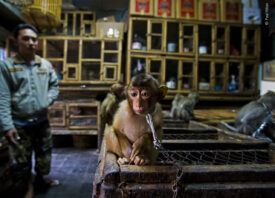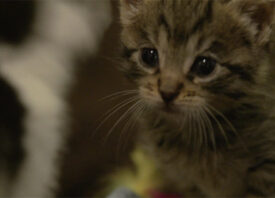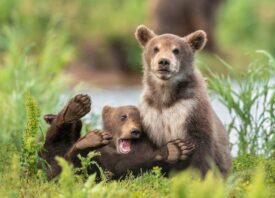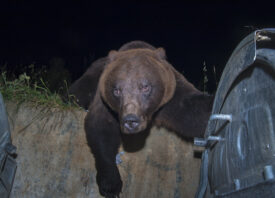Search this site
Domestic Cats and the Wildlife Crisis You Might Not Know About

“It’s one thing to read about cat predation,” the photographer Jak Wonderly tells us. “It’s quite another to hold 232 victims in your hands.” In 2020, he teamed up with Melanie Piazza from WildCare, a non-profit hospital for wildlife in California, to help memorialize and tell the story of hundreds of wild animals who died after being caught by cats in 2019.
That year, over 300 birds, rodents, reptiles, and more had been admitted to the hospital due to injuries from domestic cats. Fewer than 90 survived those injuries. Piazza preserved the bodies of those who did not in hopes of bringing attention to the problem: every year, more than two billion birds and other wild animals are killed by domestic cats in the US alone. As reported by National Geographic, cats make for almost three quarters of non-natural bird deaths, more than building strikes, cars, and power lines.

“It was Melanie’s idea to track and preserve (freeze) all the bodies that died for one calendar year, specifically for a photoshoot,” Wonderly remembers. “As the numbers passed two hundred, they had to borrow freezer space at another facility.” The goal was to present them as dignified and lifelike. The bodies were carefully thawed overnight in preparation for the photoshoot, and when the time came, Piazza groomed each animal and bandaged their wounds.
“As photographers, we often try to put ourselves in front of the most beautiful, amazing subjects and locations,” Wonderly says. “But sometimes, the opposite is true; you have to try to make a compelling image from what some would find revolting.” In the end, he chose a breathtakingly beautiful northern flicker, recognizable by the vibrant orange wings, to occupy the center of the image. “They are related to woodpeckers, and I don’t know that I’ve ever seen one in my area before,” he tells us.

The photographer has been involved in wildlife rescue for some time now, and he volunteers weekly at Sonoma County Wildlife Rescue. “Spending time with the kind of people that will spend weeks nursing a squirrel back to health so it can be released is good for the soul,” he says. “We may not be saving the world, but we are certainly making a difference.”
WildCare makes that same difference every day; this fall, for instance, a leucistic Dark-eyed Junco arrived at the hospital after being caught by a cat. He was unresponsive and in respiratory distress, suffering tremors and neurologic symptoms, but the team was able to save him. “Given just one day and night in our ICU, he was soon flighted and alert,” WildCare shared on their Instagram. “After a week of care and a course of antibiotics, he was released back to the wild.”
Wonderly has known about WildCare for years, and he’s taken his daughter there for a tour to learn about their work. During the photoshoot, members of the public were able to see the animals who’d died and pay their respects. “The photography was done in the museum area at WildCare, which is visible to the public when they enter the building (this is pre-Covid),” Wonderly remembers.
“So while we had blocked the entry to the room off, our arrangement of animals was visible to those that happened to come in that day. People were quite moved once they understood what we were doing, and one said they were going to immediately change how they handled their cat.”
The arrangement of the bodies became an intuitive process, as Wonderly knew he didn’t want formal rows or a true, abstract mandala. Once he had spread the northern flicker’s wings and secured them with wire, he placed the hummingbirds around the body, and continued until all 232 animals had been laid down.

“We were definitely on a time clock with the photography,” he remembers. “It essentially took one entire day. It was Valentine’s Day–from about 9:00 AM to 6:00 PM, if I remember correctly. As the bodies warmed up, they were prone to leaking bodily fluids. There was no moving them once they were down, as they often bled onto the white background.
“I did not want to do any Photoshop work on the final image, so we had to get the animals down and photographed and wrap it up as quickly as possible. I was intensely focused but also emotionally moved. Knowing that each one of these animals died from a cat attack, and that their death was largely preventable, was very sad.”
As a lifelong cat person, the photographer also sees it as his responsibility to help spread awareness and do his part to prevent injuries to wildlife. “I absolutely love cats, but humans have created an unfortunate situation where we are introducing a domestic animal into a wild ecosystem,” he explains.

“All we need to do to help is read a little on the issue and consider what impact our cats may be having on the wildlife in our area. Do you have bird feeders close to the house? Most people never even consider that they’re luring small birds with food and then releasing a predator on them every day.
“There are many solutions to reducing the impact of domestic cats. Obviously, you can keep them inside, but there are also collars with bright colors that cut down on their hunting success, catios, and window boxes. You can leash train your cats (which is what I did) or keep the cat indoors during peak hunting hours.”
Cats and wild animals can peacefully coexist, as long as humans are responsible. “Wildlife conservation is often thought of as something that happens in places like Africa, or in the jungle in Asia,” Wonderly says. “But the issues are the same, whether the animals are near or far, large or small, exotic or commonplace. We can make a big difference in our own backyard, if we only know what to do.”
You can also help by supporting WildCare. Donate here; become a member, or sponsor a baby animal. Follow their work on Instagram at @wildcarebayarea.



